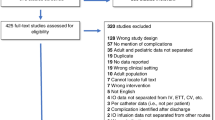Abstract
We reviewed the charts of 25 patients who underwent powered intraosseous line insertion between July 1, 2008 and August 31, 2010 to determine its users, indications, procedural details, success rates, and complications. Intraosseous (IO) line was inserted in the anteromedial aspect of the proximal tibia in all patients. The first attempt was successful in 80%, and the median duration for insertion of the IO line was 4 hours. Extravasation was the most common complication. Ninety-six percent of the physicians had undergone prior training in IO insertion. Because of its high success and short procedure time, IO access should be the first alternative to failed vascular access in critically ill children. Training in IO should be extended to all who care for pediatric patients in inpatient as well as in prehospital and emergency department settings.
Similar content being viewed by others
References
Kanter RK, Zimmerman JJ, Strauss RH, Stoeckel KA. Pediatric emergency intravenous access. Evaluation of a protocol. Am J Dis Child. 1986;140:132–134.
Banerjee S, Singhi SC, Singh S, Singh M. The intraosseous route is a suitable alternative to intravenous route for fluid resuscitation in severely dehydrated children. Indian Pediatr. 1994;31:1511–1520.
Hartman ME, Cheifetz IM. Pediatric Emergencies and Resuscitation. In: Kleigman RM, Stanton BF, Ill JWG, Schor NF, Behrman RE, editors. Nelson Textbook of Pediatrics. 19th ed. Elsevier Saunders, Philadelphia; 2011. p. 279–296.
Blumberg SM, Gorn M, Crain EF. Intraosseous infusion: a review of methods and novel devices. Pediatr Emerg Care. 2008;24:50–59.
Frascone RJ, Jensen J, Wewerka SS, Salzman JG. Use of the pediatric EZ-IO needle by emergency medical services providers. Pediatr Emerg Care. 2009;25:329–332.
Schwartz D, Amir L, Dichter R, Figenberg Z. The use of a powered device for intraosseous drug and fluid administration in a national EMS: a 4-year experience. J Trauma. 2008;64:650–655.
Gazin N, Auger H, Jabre P, Jaulin C, Lecarpentier E, Bertrand C, Margenet A, et al. Efficacy and safety of the EZ-IOTM intraosseouss device: Out-of-hospital implementation of a management algorithm for difficult vascular access. Resuscitation. 2011;82:126–129.
Lamhout L, Dagron C, Apriotesei R, Gouvernaire J, Elie C, Marx JS, et al. Comparison of intravenous and intraosseous access by pre-hospital medical emergency personnel with and without CBRN protective equipment. Resuscitation. 2010;81:65–68.
Nijssen-Jordan C. Emergency department utilization and success rates for intraosseous infusion in pediatric resuscitations. CJEM. 2000;2:10–14.
Glaeser PW, Hellmich TR, Szewczuga D. Five-year experience in prehospital intraosseous infusions in children and adults. Ann Emerg Med. 1993;22:1119–1124.
Douglas W. Carlson, Gregg A. DiGiulio, Timothy G. Givens et al. Illustrated Techniques of Pediatric Emergency Procedures. In: Fleisher GR, Ludwing S, Silverman BK, editors. Textbook of Pediatric Emergency Medicine. 6th ed. Lippincott Williams &Wilkins, Philadelphia; 2010.p.1744–1842.
Rosetti VA, Thompson BM, Miller J, Mateer JR, Aprahamian C. Intraosseous infusion: an alternative route of pediatric intravascular access. Ann Emerg Med. 1985;14:885–888.
Fiorito BA, Mirza F, Doran TM, Oberle AN, Vince Cruz EC, Wendtland CL, et al. Intraosseous access in the setting of pediatric critical care transport. Pediatr Crit Care Med. 2005;6:50–53.
Author information
Authors and Affiliations
Corresponding author
Rights and permissions
About this article
Cite this article
Oksan, D., Ayfer, K. Powered intraosseous device (EZ-IO) for critically ill patients. Indian Pediatr 50, 689–691 (2013). https://doi.org/10.1007/s13312-013-0192-z
Received:
Revised:
Accepted:
Published:
Issue Date:
DOI: https://doi.org/10.1007/s13312-013-0192-z




